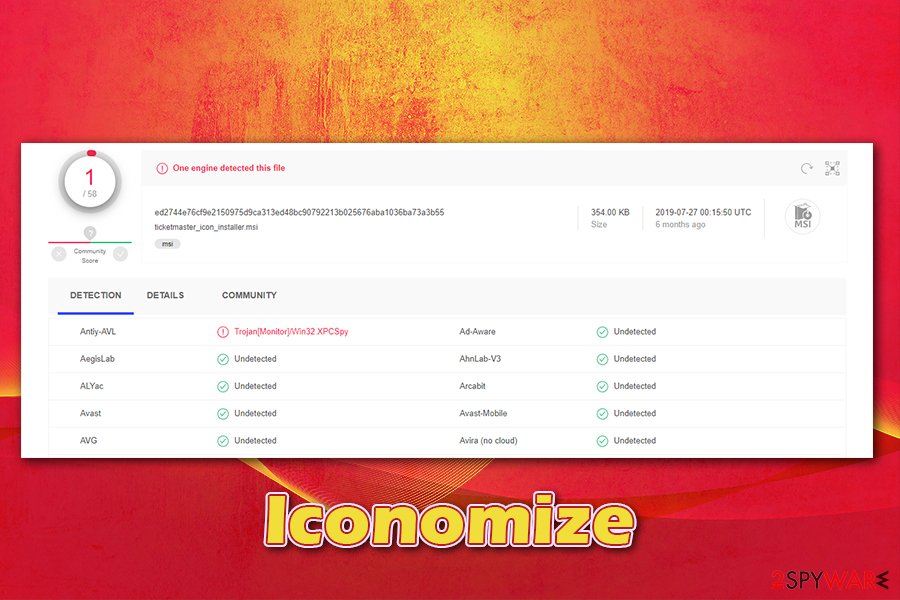Iconomize (Removal Guide) - updated Feb 2020
Iconomize Removal Guide
What is Iconomize?
Iconomize is an adware app that usually gets installed along other programs downloaded from third-party sites

Iconomize is a potentially unwanted program[1] that users typically download from the internet unintentionally, mainly because it is spread via a deceptive marketing tactic known as software bundling. Usually, multiple applications are compiled into a single installation wizard, and optional components are hidden from users' sight deliberately, making users miss the point of entry. However, soon after the infiltration, they might notice that Iconomize redirects to suspicious domains, and ads start appearing seemingly out of nowhere.
Soon after the installation, Iconomize appends an extension to Google Chrome, Mozilla Firefox, MS Edge, pr Safari, and modifies the browsers' settings. This allows the potentially unwanted program to display sponsored links, pop-ups, in-text links, deals, offers, banners, and other intrusive and low-quality commercial content to users. Besides, the application is also known for its information tracking activities, putting users' privacy at risk. If you found the app installed on your system unexpectedly, you should remove Iconomize by following our instructions below.
| Name | Iconomize |
| Type | Adware, potentially unwanted program |
| Infiltration | Most PUPs are delivered with the help of freeware bundle installers downloaded from third-party sites, although users may install them after seeing an attractive ad online |
| Advertised functionality | App developers claim that it is an “icon installer” that allows creating shortcuts to favorite sites directly on the desktop |
| Symptoms |
|
| Risks | Installation of other potentially unwanted programs, malware infections [rare], money loss due to encountered scams, etc. |
| Termination | You can get rid of the unwanted application by following our manual removal guide below or scan the machine with reputable anti-malware software |
| Recovery & optimization | To restore your computer to pre-infection stage and ensure its optimization, we recommend using FortectIntego |
On the official Iconomize.com domain, the developers of that the application claim is designed to create shortcuts (directly on your desktop) which, once clicked, lead you to predetermined websites, such as eBay or Amazon, and call it a “Desktop Shortcut Icon Installer.” Allegedly, this functionality is useful because it prevents users from visiting fake sites that try to steal users' credentials or steal banking information:
The eBay Icon Installer was developed in retaliation to the growing number of fraudulent websites disguised as our favorite websites so that you willfully type in your username and password and unknowingly hand it to them on a silver platter. Within seconds of accidentally falling for this scam, your account can be compromised and inflicted with an unpredictable amount of damages.
While it is true that fake websites exist, they are not that common as presented by this developer – you will not find a fake link at the top of your Google search results. In other words, to access a bogus site, you must receive a phishing email, visit a shady website, or be redirected by aggressive adware.
The usefulness of Iconomize functionality is highly debatable, although some might find the feature somewhat useful (note that desktop shortcuts can be created manually[2] via the web browser or placed on the favorite bar of the browser). In other words, Iconomize is there to deliver your ads, and that is the main goal of it.
Once you install Iconomize, you might see all or some of the following symptoms:
- Advertisement banners appear on all visited domains
- Redirects lead to suspicious websites filled with ads
- Homepage, new tab address and the search engine altered to something else
- Random text is turned into hyperlinks that lead to affiliated sites
- Browser response time takes longer
- Search results are filled with sponsored ad material
- Websites claiming virus infections or showing fake Flash update prompts appear regularly, etc.

Ads by Iconomize might diminish the web browsing experience greatly, as they may even cover the underlying content of a visited site. Besides, by modifying search results and showing sponsored links at the time, the PUP essentially changes the way users browse and even what they buy. In some cases, the app was even called “Iconomize virus,” as redirects appear as follows:
ww1.Iconomize.com/redirect/ [name of landing page].
While the name does not match Iconomize technically (it does not infect application or system files, but rather places its files on the system), its web aggressive advertising practices, deceptive distribution methods, and spying on users' web browsing activities might just be enough to justify it.
We recommend performing Iconomize removal by following our step-by-step guide below or employing anti-malware software that can recognize potentially unwanted applications. Additionally, using FortectIntego repair tool and resetting all the installed browsers might be useful after the app's termination.
Watch out for optional components when installing software
As mentioned above, potentially unwanted programs typically spread with the help of software bundling – this technique allows third-party sites to monetize on each install made by users (pay-per-install[3] scheme) and freeware developers to popularize the software that displays the ads. Unfortunately, users are the ones left with a borderline malicious application that may compromise online safety, as well as computer security. Luckily, most of the PUPs are relatively harmless which it comes to a malware installation, although most do practice information tracking.
Therefore, if you want to prevent the installation of potentially unwanted applications, you should start checking your downloads more carefully. It's not adequate to click the Next button all the time to complete the installation. In order to prevent the infiltration of optional programs within software packages, you should opt for Advanced/Custom installation all the time and go through the entire process step by step to detect and deselect additional components. Additionally, it is always advised to download software from official sources like Microsoft Store, Amazon, App Store, Google Play, etc., as these sources do not bundle apps, and you can be sure that you are getting only what you opted in for.

Iconomize removal guide
There are two ways you can remove Iconomize from your computer – manual and automatic. Both of these can be successful, but it also depends on your system configuration, already installed programs, and many other factors. Nevertheless, you can get rid of the so-called Iconomize virus by checking the installed application list via the Control Panel (Windows) or Applications folder (macOS) and get rid of everything suspicious.
After Iconomize removal, we highly recommend resetting all the installed browsers, as the PUP adds a browser extension. Nevertheless, you might be able to terminate it manually by right-clicking on the extension and selecting Remove. You will find the guide on how to reset browsers below.
You may remove virus damage with a help of FortectIntego. SpyHunter 5Combo Cleaner and Malwarebytes are recommended to detect potentially unwanted programs and viruses with all their files and registry entries that are related to them.
Getting rid of Iconomize. Follow these steps
Uninstall from Windows
To remove Iconomize from Windows computers, access Control panel as follows:
Instructions for Windows 10/8 machines:
- Enter Control Panel into Windows search box and hit Enter or click on the search result.
- Under Programs, select Uninstall a program.

- From the list, find the entry of the suspicious program.
- Right-click on the application and select Uninstall.
- If User Account Control shows up, click Yes.
- Wait till uninstallation process is complete and click OK.

If you are Windows 7/XP user, proceed with the following instructions:
- Click on Windows Start > Control Panel located on the right pane (if you are Windows XP user, click on Add/Remove Programs).
- In Control Panel, select Programs > Uninstall a program.

- Pick the unwanted application by clicking on it once.
- At the top, click Uninstall/Change.
- In the confirmation prompt, pick Yes.
- Click OK once the removal process is finished.
Delete from macOS
You need to reach Applications section on macOS to terminate PUPs:
Remove items from Applications folder:
- From the menu bar, select Go > Applications.
- In the Applications folder, look for all related entries.
- Click on the app and drag it to Trash (or right-click and pick Move to Trash)

To fully remove an unwanted app, you need to access Application Support, LaunchAgents, and LaunchDaemons folders and delete relevant files:
- Select Go > Go to Folder.
- Enter /Library/Application Support and click Go or press Enter.
- In the Application Support folder, look for any dubious entries and then delete them.
- Now enter /Library/LaunchAgents and /Library/LaunchDaemons folders the same way and terminate all the related .plist files.

Remove from Microsoft Edge
Delete unwanted extensions from MS Edge:
- Select Menu (three horizontal dots at the top-right of the browser window) and pick Extensions.
- From the list, pick the extension and click on the Gear icon.
- Click on Uninstall at the bottom.

Clear cookies and other browser data:
- Click on the Menu (three horizontal dots at the top-right of the browser window) and select Privacy & security.
- Under Clear browsing data, pick Choose what to clear.
- Select everything (apart from passwords, although you might want to include Media licenses as well, if applicable) and click on Clear.

Restore new tab and homepage settings:
- Click the menu icon and choose Settings.
- Then find On startup section.
- Click Disable if you found any suspicious domain.
Reset MS Edge if the above steps did not work:
- Press on Ctrl + Shift + Esc to open Task Manager.
- Click on More details arrow at the bottom of the window.
- Select Details tab.
- Now scroll down and locate every entry with Microsoft Edge name in it. Right-click on each of them and select End Task to stop MS Edge from running.

If this solution failed to help you, you need to use an advanced Edge reset method. Note that you need to backup your data before proceeding.
- Find the following folder on your computer: C:\\Users\\%username%\\AppData\\Local\\Packages\\Microsoft.MicrosoftEdge_8wekyb3d8bbwe.
- Press Ctrl + A on your keyboard to select all folders.
- Right-click on them and pick Delete

- Now right-click on the Start button and pick Windows PowerShell (Admin).
- When the new window opens, copy and paste the following command, and then press Enter:
Get-AppXPackage -AllUsers -Name Microsoft.MicrosoftEdge | Foreach {Add-AppxPackage -DisableDevelopmentMode -Register “$($_.InstallLocation)\\AppXManifest.xml” -Verbose

Instructions for Chromium-based Edge
Delete extensions from MS Edge (Chromium):
- Open Edge and click select Settings > Extensions.
- Delete unwanted extensions by clicking Remove.

Clear cache and site data:
- Click on Menu and go to Settings.
- Select Privacy, search and services.
- Under Clear browsing data, pick Choose what to clear.
- Under Time range, pick All time.
- Select Clear now.

Reset Chromium-based MS Edge:
- Click on Menu and select Settings.
- On the left side, pick Reset settings.
- Select Restore settings to their default values.
- Confirm with Reset.

Remove from Mozilla Firefox (FF)
Adware apps often change the settings of the web browser – alter the homepage, insert cookies, etc. To stop the underlying activity of Iconomize hijack, we suggest you reset Mozilla Firefox as explained below:
Remove dangerous extensions:
- Open Mozilla Firefox browser and click on the Menu (three horizontal lines at the top-right of the window).
- Select Add-ons.
- In here, select unwanted plugin and click Remove.

Reset the homepage:
- Click three horizontal lines at the top right corner to open the menu.
- Choose Options.
- Under Home options, enter your preferred site that will open every time you newly open the Mozilla Firefox.
Clear cookies and site data:
- Click Menu and pick Settings.
- Go to Privacy & Security section.
- Scroll down to locate Cookies and Site Data.
- Click on Clear Data…
- Select Cookies and Site Data, as well as Cached Web Content and press Clear.

Reset Mozilla Firefox
If clearing the browser as explained above did not help, reset Mozilla Firefox:
- Open Mozilla Firefox browser and click the Menu.
- Go to Help and then choose Troubleshooting Information.

- Under Give Firefox a tune up section, click on Refresh Firefox…
- Once the pop-up shows up, confirm the action by pressing on Refresh Firefox.

Remove from Google Chrome
Delete malicious extensions from Google Chrome:
- Open Google Chrome, click on the Menu (three vertical dots at the top-right corner) and select More tools > Extensions.
- In the newly opened window, you will see all the installed extensions. Uninstall all the suspicious plugins that might be related to the unwanted program by clicking Remove.

Clear cache and web data from Chrome:
- Click on Menu and pick Settings.
- Under Privacy and security, select Clear browsing data.
- Select Browsing history, Cookies and other site data, as well as Cached images and files.
- Click Clear data.

Change your homepage:
- Click menu and choose Settings.
- Look for a suspicious site in the On startup section.
- Click on Open a specific or set of pages and click on three dots to find the Remove option.
Reset Google Chrome:
If the previous methods did not help you, reset Google Chrome to eliminate all the unwanted components:
- Click on Menu and select Settings.
- In the Settings, scroll down and click Advanced.
- Scroll down and locate Reset and clean up section.
- Now click Restore settings to their original defaults.
- Confirm with Reset settings.

Delete from Safari
Remove unwanted extensions from Safari:
- Click Safari > Preferences…
- In the new window, pick Extensions.
- Select the unwanted extension and select Uninstall.

Clear cookies and other website data from Safari:
- Click Safari > Clear History…
- From the drop-down menu under Clear, pick all history.
- Confirm with Clear History.

Reset Safari if the above-mentioned steps did not help you:
- Click Safari > Preferences…
- Go to Advanced tab.
- Tick the Show Develop menu in menu bar.
- From the menu bar, click Develop, and then select Empty Caches.

After uninstalling this potentially unwanted program (PUP) and fixing each of your web browsers, we recommend you to scan your PC system with a reputable anti-spyware. This will help you to get rid of Iconomize registry traces and will also identify related parasites or possible malware infections on your computer. For that you can use our top-rated malware remover: FortectIntego, SpyHunter 5Combo Cleaner or Malwarebytes.
How to prevent from getting adware
Protect your privacy – employ a VPN
There are several ways how to make your online time more private – you can access an incognito tab. However, there is no secret that even in this mode, you are tracked for advertising purposes. There is a way to add an extra layer of protection and create a completely anonymous web browsing practice with the help of Private Internet Access VPN. This software reroutes traffic through different servers, thus leaving your IP address and geolocation in disguise. Besides, it is based on a strict no-log policy, meaning that no data will be recorded, leaked, and available for both first and third parties. The combination of a secure web browser and Private Internet Access VPN will let you browse the Internet without a feeling of being spied or targeted by criminals.
No backups? No problem. Use a data recovery tool
If you wonder how data loss can occur, you should not look any further for answers – human errors, malware attacks, hardware failures, power cuts, natural disasters, or even simple negligence. In some cases, lost files are extremely important, and many straight out panic when such an unfortunate course of events happen. Due to this, you should always ensure that you prepare proper data backups on a regular basis.
If you were caught by surprise and did not have any backups to restore your files from, not everything is lost. Data Recovery Pro is one of the leading file recovery solutions you can find on the market – it is likely to restore even lost emails or data located on an external device.
- ^ Chris Hoffman. PUPs Explained: What is a “Potentially Unwanted Program”?. How-To Geek. Site that explains technology.
- ^ Daniel P. Howley. How to Create Desktop Shortcuts for Web Pages Using Chrome. Laptopmag. Reviews and benchmarks for latest laptops.
- ^ What is pay per install. Quora. Question-answer site.























